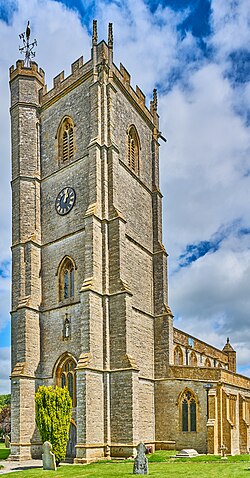
The Church of St Mary the Virgin, widely known as St Mary Redcliffe, is the main Church of England parish church for the Redcliffe district of the city of Bristol, England. The first reference to a church on the site appears in 1158, with the present building dating from 1185 to 1872. The church is considered one of the country's finest and largest parish churches as well as an outstanding example of English Gothic architecture. The church is so large it is sometimes mistaken for Bristol Cathedral by tourists. The building has Grade I listed status, the highest possible category, by Historic England.

John Taylor Bell Foundry (Loughborough) Limited, trading as John Taylor & Co and commonly known as Taylor's Bell Foundry, Taylor's of Loughborough, or simply Taylor's, is the world's largest working bell foundry. It is located in Loughborough, in the Charnwood borough of Leicestershire, England. The business originated in the 14th century, and the Taylor family took over in 1784.

Queen Camel is a village and civil parish, on the River Cam and the A359 road, in the unitary authority of Somerset, England. It is about 7 miles (11.3 km) north of Yeovil. According to the 2011 census it had a population of 908. The parish includes the hamlet of Wales. Nearby places are West Camel, Sparkford and Marston Magna.
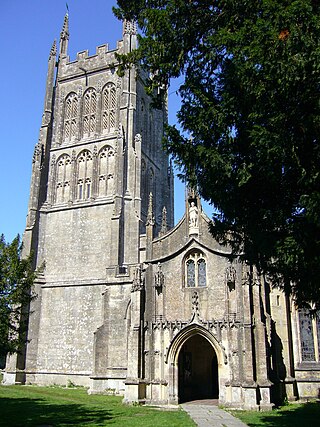
St Andrew's Church is a Church of England parish church located in the village of Mells in the English county of Somerset. The church is a grade I listed building.
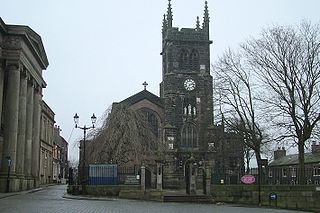
St Michael and All Angels Church overlooks Market Place in the town of Macclesfield, Cheshire, England. It is an active Anglican parish church in the diocese of Chester, the archdeaconry of Macclesfield and the deanery of Macclesfield. It forms a team parish with three other Macclesfield churches: All Saints, St Peter's and St Barnabas'. The church is recorded in the National Heritage List for England as a designated Grade II* listed building.

St Barnabas' Church is in the town of Bromborough, Wirral, Merseyside, England. The church is recorded in the National Heritage List for England as a designated Grade II* listed building, and stands within the boundary of the Bromborough Village Conservation Area. It is an active Anglican parish church in the diocese of Chester, the archdeaconry of Chester and the deanery of Wirral South. The authors of the Buildings of England series describe it a "handsome church for a village-gone-prosperous". It is considered to be a well-designed example of the work of Sir George Gilbert Scott. In the churchyard are three Anglo-Saxon carved stones which have been reconstructed to form a cross.

Tredington is a village and civil parish on the River Stour in Warwickshire, England. The village is 2 miles (3 km) north of Shipston-on-Stour. The civil parish includes the village of Newbold on Stour and hamlets of Armscote, Blackwell and Darlingscott. The 2011 Census recorded the parish population as 1,422. Tredington civil parish was part of Worcestershire until 1931. The River Stour runs through Tredington.
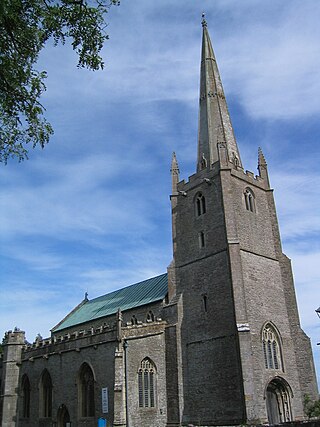
The Anglican Church of St Andrew in Congresbury, Somerset, England dates from the 13th century and has been designated as a Grade I listed building.
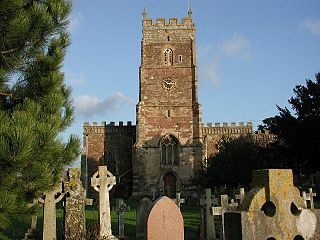
St Mary's Church in Portbury, Somerset, England, is an Anglican parish church close to the M5 motorway. It is a Grade I listed building.

The Church of All Saints is the Church of England parish church for the large village of Wrington, Somerset, England. There has been a church here since the 13th century, though much of the present building dates from the 15th century. Historic England have designated it a Grade I listed building.

Taunton Minster (St Mary Magdalene church) is a Church of England parish minster church in Taunton, Somerset, England, dedicated to Jesus' companion Mary Magdalene. It was completed in 1508 and is in the Early Tudor Perpendicular Gothic style. It is designated as a Grade I listed building. It is notable for its very tall tower.
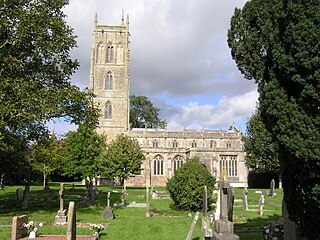
The Church of St Andrew in Cheddar, Somerset, England dates from the 14th century and has been designated as a Grade I listed building.

The Church of St Mary the Blessed Virgin is a Church of England parish church in East Brent, Somerset, England. It was built in the 15th century is a Grade I listed building.

The Anglican Church of St Peter and St Paul in Kilmersdon, Somerset, England, dates back to the Norman period, though much of the current structure was built during the 15th and 16th centuries and restored in the Victorian era. It is a Grade I listed building.

The Church of St Mary in Bruton, Somerset, England was largely built in the 14th century. Like many Somerset churches, it has a very fine tower; less usually it has a second one as well. Simon Jenkins has called Bruton's tower "Somerset architecture at its most powerful." It has been designated a Grade I listed building.

The Church of St Mary in Ilminster, Somerset, England, dates from the 15th century and has been designated as a Grade I listed building.

Cretingham is a village and a civil parish in the East Suffolk district, in the English county of Suffolk. It is on the River Deben, 2 miles south off the A1120 road. It is four miles west from Framlingham and eight miles northwest from Woodbridge.

St Mary's Church, Westham, is an active Anglican parish church in High Street, Westham, East Sussex, England, standing to the west of Pevensey Castle. The earliest fabric in the church, in the south wall of the nave and in the transept, dates from the late 11th century. The north aisle and the tower were added to the church in the late 14th century. The chancel was either rebuilt or remodelled in about 1420. During the 1870s restorations were carried out, including one by the Lancaster architects Paley and Austin in 1876–77, when the seating was increased from 297 to 403. The church is constructed in flint with stone dressings and a tiled roof. Its plan consists of a nave with a north aisle and a north porch, a south transept, a chancel with a north chapel, and a west tower.

St Edmund's Church, Castleton, is a Grade II* listed parish church in the Church of England in Castleton, Derbyshire.

The Church of St Michael and All Angels is the main Church of England parish church for the suburb of Heavitree, located in the city of Exeter, Devon. The present building is a large and imposing Gothic Revival structure dating back to the 19th century but there has been a church on the site since Saxon times. Designated as a Grade II* listed building by Historic England, the church is notable for its Victorian architecture, tall tower and proximity to the 'Heavitree Yew', an ancient common yew tree within the churchyard amongst the oldest in the county.
